13.1 创建项目
创建vue
# 初始化vue项目
vue init webpack hello-vue
cd hello-vue
# 安装vue-router
npm install vue-router --save-dev
# 安装element-ui
npm i element-ui -S
# 安装所有依赖
npm install
# 依赖安装报错,执行
npm audit fix
# 安装 SASS 加载器
cnpm install sass-loader node-sass --save-dev
# 启动测试
npm run dev
npm install moduleName:安装模块到项目目录下npm install -g moduleName:-g的意思是将模块安装到全局,具体安装到磁盘哪个位置要看npm config prefix的位置npm install -save moduleName:–save的意思是将模块安装到项目目录下, 并在package文件的dependencies节点写入依赖,-S为该命令的缩写npm install -save-dev moduleName:–save-dev的意思是将模块安装到项目目录下,并在package文件的devDependencies节点写入依赖,-D为该命令的缩写
导入IDEA,创建目录
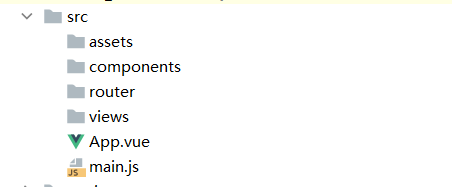
assets存放资源文件components存放一些功能性组件views存放一些视图的组件router存放路由跳转的组件
13.2 编写代码
Main.vue
<template>
<h1>首页</h1>
</template>
<script>
export default {
name: "Main"
}
</script>
<style scoped>
</style>
Login.vue
<template>
<div>
<el-form ref="loginForm" :model="form" :rules="rules" label-width="80px" class="login-box">
<h3 class="login-title">欢迎登录</h3>
<el-form-item label="账号" prop="username">
<el-input type="text" placeholder="请输入账号" v-model="form.username"/>
</el-form-item>
<el-form-item label="密码" prop="password">
<el-input type="password" placeholder="请输入密码" v-model="form.password"/>
</el-form-item>
<el-form-item>
<el-button type="primary" v-on:click="onsubmit('loginForm')">登录</el-button>
</el-form-item>
</el-form>
<el-dialog title="温馨提示" :visible.sync="dialogVisiable" width="30%" :before-close="handleClose">
<span>请输入账号和密码</span>
<span slot="footer" class="dialog-footer">
<el-button type="primary" @click="dialogVisible = false">确定</el-button>
</span>
</el-dialog>
</div>
</template>
<script>
export default {
name: "Login",
data(){
return{
form:{
username:'',
password:''
},
//表单验证,需要在 el-form-item 元素中增加prop属性
rules:{
username:[
{required:true,message:"账号不可为空",trigger:"blur"}
],
password:[
{required:true,message:"密码不可为空",tigger:"blur"}
]
},
//对话框显示和隐藏
dialogVisible:false
}
},
methods:{
onSubmit(formName){
//为表单绑定验证功能
this.$refs[formName].validate((valid)=>{
if(valid){
//使用vue-router路由到指定界面,该方式称为编程式导航
this.$router.push('/main');
}else{
this.dialogVisible=true;
return false;
}
});
}
}
}
</script>
<style lang="scss" scoped>
.login-box{
border:1px solid #DCDFE6;
width: 350px;
margin:180px auto;
padding: 35px 35px 15px 35px;
border-radius: 5px;
-webkit-border-radius: 5px;
-moz-border-radius: 5px;
box-shadow: 0 0 25px #909399;
}
.login-title{
text-align:center;
margin: 0 auto 40px auto;
color: #303133;
}
</style>
main.js
//导入vue组件
import Vue from 'vue'
import App from './App'
//导入vue-router
import router from './router'
//导入element-ui
import ElementUI from 'element-ui';
import 'element-ui/lib/theme-chalk/index.css';
//加载路由
Vue.use(router);
//加载ElementUI
Vue.use(ElementUI);
new Vue({
el: '#app',
router, //配置路由
render: h => h(App) //ElementUI 配置
})
App.vue
<template>
<div id="app">
<h1>恨劫的hello vue</h1>
<router-link to="/main">首页</router-link>
<router-link to="/login">登录页</router-link>
<router-view></router-view>
</div>
</template>
<script>
export default {
name: 'App',
}
</script>
13.3 错误整理与效果图
首次运行报错

排查发现是"sass-loader": "^11.0.1",版本过高导致,因此需要降低版本
解决方式
降低版本至:"sass-loader": "^7.3.1",
然后重新安装依赖npm install
效果展示

13.4 嵌套路由
嵌套路由,又称子路由,在实际应用中,通常用多层嵌套的组件组合而成。
用户信息组件 Profile.vue
<template>
<h1>个人信息</h1>
</template>
<script>
export default {
name: "UserProfile" //文件名可以不和暴露的名一样,引入组件时引入这里的名字
}
</script>
<style scoped>
</style>
用户列表组件
<template>
<h1>用户列表</h1>
</template>
<script>
export default {
name: "UserList"
}
</script>
<style scoped>
</style>
修改Main.vue 应用ElementUI
<template>
<div>
<el-container>
<el-aside width="200px">
<el-menu :default-openeds="['1']">
<el-submenu index="1">
<template slot="title"><i class="el-icon-caret-right"></i>用户管理</template>
<el-menu-item-group>
<el-menu-item index="1-1">
<!--插入的地方-->
<router-link to="/user/profile">个人信息</router-link>
</el-menu-item>
<el-menu-item index="1-2">
<!--插入的地方-->
<router-link to="/user/list">用户列表</router-link>
</el-menu-item>
</el-menu-item-group>
</el-submenu>
<el-submenu index="2">
<template slot="title"><i class="el-icon-caret-right"></i>内容管理</template>
<el-menu-item-group>
<el-menu-item index="2-1">分类管理</el-menu-item>
<el-menu-item index="2-2">内容列表</el-menu-item>
</el-menu-item-group>
</el-submenu>
</el-menu>
</el-aside>
<el-container>
<el-header style="text-align: right; font-size: 12px">
<el-dropdown>
<i class="el-icon-setting" style="margin-right: 15px"></i>
<el-dropdown-menu slot="dropdown">
<el-dropdown-item>个人信息</el-dropdown-item>
<el-dropdown-item>退出登录</el-dropdown-item>
</el-dropdown-menu>
</el-dropdown>
</el-header>
<el-main>
<!--在这里展示视图-->
<router-view />
</el-main>
</el-container>
</el-container>
</div>
</template>
<script>
export default {
name: "Main"
}
</script>
<style scoped lang="scss">
.el-header {
background-color: #B3C0D1;
color: #333;
line-height: 60px;
}
.el-aside {
color: #333;
}
</style>
13.41 添加嵌套路由
import vue from 'vue'
import VueRouter from 'vue-router'
import Main from "../views/Main"
import Login from "../views/Login";
import List from "../views/user/List";
import Profile from "../views/user/Profile";
vue.use(VueRouter);
export default new VueRouter({
routes: [
{
path: '/main',
component: Main,
children: [
//嵌套路由
{
path:'/user/profile',
component: Profile
},{
path: '/user/list',
component: List
}
]
},{
path: '/login',
component: Login,
}
]
});
父路由在跳转的内容下的部分,再进行跳转
效果图
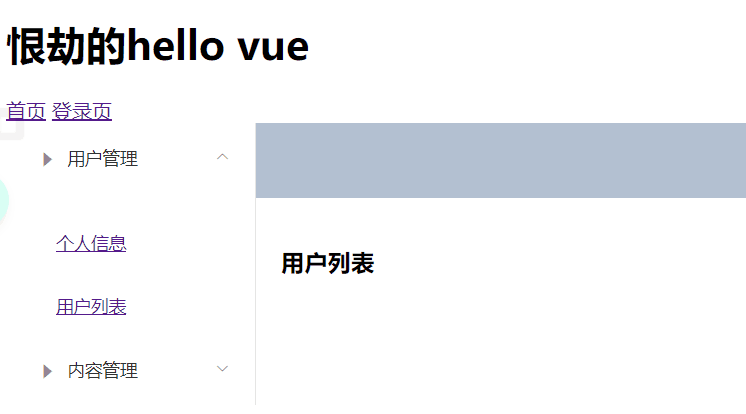
父路由用来控制,首页和登录页两个组件的跳转
子路由在父路由跳转的内容下,控制子组件的跳转。
13.5 参数传递
方式一:
修改Main.vue
<el-menu-item index="1-1">
<!--插入的地方-->
<router-link v-bind:to="{name: '/user/profile',params:{id: 1}}">个人信息</router-link>
</el-menu-item>
name传递的是地址(或者组件名),通过params向==路由中==传递参数。
注意,参数传递时,vue需要一个对象,绑定一个参数值v-vind:
修改路由 index.js
//嵌套路由
{
path:'/user/profile/:id', //添加:id ,接收模板中传递的参数
component: Profile
},{
path: '/user/list',
component: List
}
修改Profile.vue
<div>
<h1>个人信息</h1>
{{$route.params.id}} //显示路由中传来的参数
</div>
- 注意:所有的元素,必须包含在标签里面。
方式二:
上面基础上,修改Main.vue
<el-menu-item index="1-1">
<!--插入的地方-->
<router-link v-bind:to="{name: 'Profile',params:{id: 1}}">个人信息</router-link>
</el-menu-item>
注:传递参数时需要在路由中给组件命名,并以名字作为模板中的属性
修改路由 index.js
children: [
//嵌套路由
{
path:'/user/profile/:id',
component: Profile,
name: 'Profile', //传递参数时需要在路由中给组件命名,
props: true //支持传递参数
},{
path: '/user/list',
component: List
}
]
修改Profile.vue
<template>
<div>
<h1>个人信息</h1>
{{id}}
</div>
</template>
<script>
export default {
props: ['id'], //接收路由传过来的参数,命名为id,路由那里需要设置props: true,允许传递参数
name: "UserProfile"
}
</script>
效果
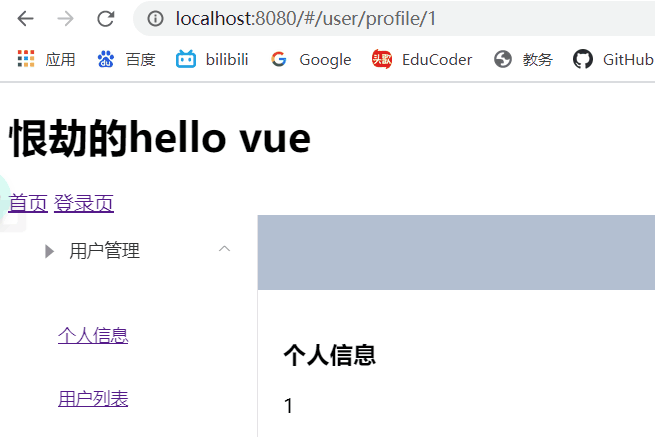
13.6 重定向
增加一个vue-router
{
path: '/gohome',
redirect: '/main' //将gohomg重定向到main
}
如此便成功设置重定向
13.7 路由模式
路由模式有两种:
- hash:路径带#符号,如http://localhost:8080/#/main
- history:路径不带#符号,如http://localhost:8080/main
修改如下:
mode: 'history', //vue-router的index.js改成history
routes: [
如此,便不带#号了
13.8 404
创建一个NotFound.vue
<template>
<h1>404 Not Found</h1>
</template>
配置路由
import NotFound from "../NotFound";
……
,{
path: '*',
component: NotFound
}
至此,404配置成功

13.9 钩子函数
beforeRouterEnter:在进入路由之前执行
beforeRouterLeave:在离开路由前执行
<script>
export default {
props: ['id'],
name: "UserProfile",
beforeRouteEnter:(to,from,next)=>{
// 在进入路由器之前执行
console.log("进入路由器之前");
// 让程序继续往下走,相当于chain
next();
},
beforeRouteLeave:(to,from,next)=>{
// 在离开路由器之前执行
console.log("离开路由器之前");
next();
}
}
</script>
to相当于request,from相当于response,next相当于chain:从哪里来,到哪里去,是否继续往下走。
参数详解:
- to:路由将要跳转的路径信息
- from:路径挑战前的路径信息
- next:路由的控制参数
- next() 跳入下一个页面
- next(‘/path’) 改变路由的跳转方向,使其跳转到另一个路由
- next(false) 返回原来的页面
- next((vm)=>{}) 仅在 beforeRouteEnter 中可用,vm 是组件实例
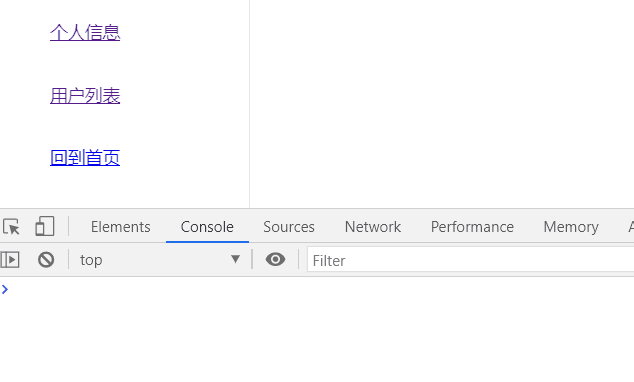
在钩子函数中使用异步请求—Axios
-
安装Axios:
npm install --save axios vue-axios -
main.js中引用 Axios:import axios from 'axios' import VueAxios from 'vue-axios' Vue.use(VueAxios, axios) -
Profile.vue<script> export default { props: ['id'], name: "UserProfile", beforeRouteEnter:(to,from,next)=>{ console.log("进入路由器之前"); next(vm => { vm.getdata(); //在进入路由之前,调用method中的getdata方法 }); }, methods: { getdata: function (){ this.axios.get('http://localhost:8080/static/mock/data.json').then(Response=>(console.log(Response.data))) } } } </script> -
测试
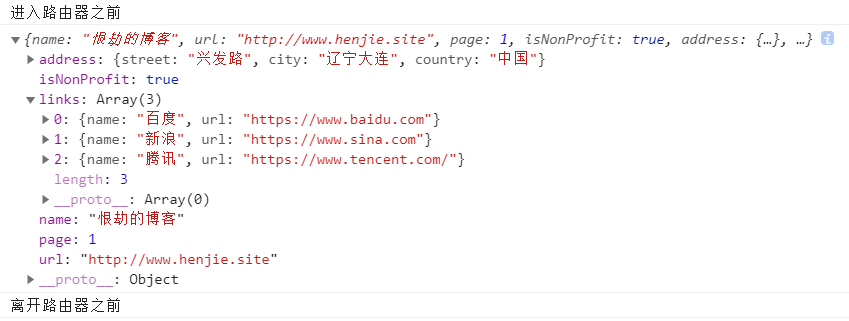






















 987
987











 被折叠的 条评论
为什么被折叠?
被折叠的 条评论
为什么被折叠?








